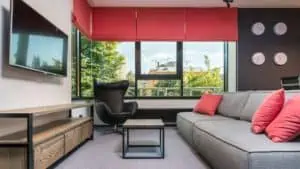Most experts on entertainment will tell you that if you are going to upgrade one thing to get the best possible home theater experience, you need to upgrade the sound. And think about it. When you go to a theater, the sound is the thing that you remember. The screen is big, sure, but it is far away and the picture quality in most theaters won’t really rival the things that your home theater can do. The thing that they’ve made big investments in is sound quality and the room to contain that sound.
In this post, we’ll discuss the best way to get the perfect home theater experience–investing in a great sound system and making that system count.
The Language of Sound
If you start shopping for the perfect set of sound for your home theater system, you’ll encounter a bunch of different speaker ads that will want to sell you on numbers and metrics that you probably have no idea how to interpret. So let’s go over some basic terminology first.
Frequency Response
This is a super important spec for your system. The frequency response basically is a number that measures the range of frequences the speaker can produce. The It also shows you how much the speaker deviates from a flat response which has a plus and minus symbol. The lower the plus minus symbol, the lower the deviation, which is better.
As for the frequency response, the higher the better. Sound quality often comes from the ability of the speakers to produce a range of sounds. Music and effects will seem far more clear when the speakers can produce sounds that are more true to the intentions of the score. Find a big frequency response, and you’ll have great sound quality.
Sensitivity
Sensitivity tells you the efficiency of the output of the speakers. Higher numbers are better here, but really anything over 90 dB will do just fine. Don’t worry too much about exact numbers on this one.
Impedance
If you’re buying speakers to pair with a different receiver, this number starts to matter. If you’re buying a package, don’t worry about it at all. Most speakers fall in the 8-ohm category, which will work with most receivers. If your speakers are less than 8-ohms, they will need a more powerful receiver.
Watts
Watts really sounds like the power of your speakers, but keep in mind that this is the watts that it takes to run your speakers, and not the watts that they put out. However, watts doesn’t mean sound, and it doesn’t mean loudness. Watts are how much power your speakers run on. You are always in better shape to pick the higher sensitivity and lower wattage speakers.
Speaker Hardware
Receivers
The receiver is the hub that controls your system, but it is also the computer that drives the central sound. Buying a better theater receiver that gives you access to HDMI and 4K movies will help you get the most of your sound. If you have bluetooth and wifi connectivity, you can even get them into your receiver itself. But don’t worry too much about that. You can add audio receiver smart connectivity after the fact if you get a receiver that you really love.
Wires
Wires are not a place where you should be spending less. The great 12 or 14 gauge wire that are running farther can give you some great sound quality. If you have an analog speaker wire, this thicker gauge will help the sound quality maintain consistency through to the speaker. If you have lower impedance on your speakers, the better wire is really important, because those speakers will strain the wire more.
Speakers
Speakers are obviously the meat and potatoes of the theater system. They help bring everything together and actually produce the sound that you’ll be enjoying with your awesome movies. Speakers include a center channel that is right below your TV, a pair of standing floor speakers that go to the left and right, and then a couple of surround speakers usually behind where you are sitting. These create the full surround sound effect.
When building a home theater, you really need to invest in a quality center channel. Often also called a sound bar in smaller setups, the center channel delivers most of the dialogue and soundtrack of the movie. If you’ve ever been frustrated by a movie in someone’s home that you couldn’t hear the dialogue for–a bad soundbar or center channel is probably at fault here.
The speakers to the right and left, as well as the surround sound speakers, set the effects and score for the movie. The score of the movie is the music that you’re hearing from the action. They front speakers sync with the screen perfectly to make sure that you get perfectly timed baseline action.
The surround speakers give you great effects. The numbers next to speakers tell you how many sounds there are. 5.1 speakers have a single pair of surround sound speakers, and they can either be placed right next to you or behind you. A 7.1 system will use both speakers that are next to you and speakers that are behind you.
Acoustics and Soundproofing
Finally, there is one more thing that you’ll have to do to get that theater quality sound. You’ll need to have a room that has great acoustics and can absorb sound. If possible, you’ll want to build a separate home theater room that has insulation and soundproofing to allow you to crank the volume without upsetting anyone else in your home. Remember, the average wall won’t do a lot to stop noise from traveling!
If you can’t do the whole room, at least invest in some absorbing panels that will prevent noise from traveling outside the room. Absorbing panels usually don’t look great on the walls, as they are foam triangles. But with a little creativity they should integrate nicely into a home theater setting.





